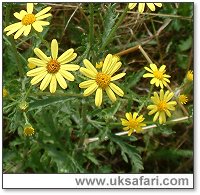
|

|
|
 Sent
to you Sent
to you
by e-mail
|
|
Simply
enter your details and hit the send button
more
info |
|


Click Here

Links
Advertise
Terms of Use
Contributors
About Us
Contact Us
|
 |
Go back
 | Bookmark
| Bookmark
 | Print Page
| Print Page  | E-Mail Us
| E-Mail Us 
 

Photo: G. Bradley
|
|
UK
Safari Tip:
One of the best field guides to wild flowers in this one at the Amazon
bookshop - click
here
|
|
Latin name: Senecio squalidus
Size: Approximately 20 to 120cms tall - depending on the species
Distribution: Found throughout most of the U.K.
Flowering Months: May to December
Habitat: Wasteground, roadsides, railway sidings, under or over-grazed pasture.
Prefers low fertility soils.
Special features: Ragwort gets its name from its ragged edged leaves.
The Oxford Ragwort (above) was originally
brought to the Oxford Botanical Gardens from the rocky mountainsides of Italy.
When it escaped into the surrounding countryside, the nearby stony railway
sidings provided the perfect growing environment. As the trains sped past, the
draught caused the windborne seeds to spread up and down the lines, and
throughout the U.K.
The other factor in the success of the Ragwort is the number of flowers it
produces. The average plant will have well in excess of a hundred flowers and
these produce thousands of seeds.
Ragwort is quite an attractive plant when in bloom, but it is poisonous to grazing
animals. It is a particular hazard to horses and cattle. Ragwort poisoning,
or 'Ragwort toxicosis', destroys the liver, leading to slow, painful death.
In it's first year of growth, the Ragwort plant produces a small rosette of leaves. This
is when it is most poisonous. In its second year it produces stems and flowers.
Horses usually know which plants are good to eat. Ragwort has a bitter taste when fresh, but
after a few days it loses this taste. Similarly when it has been cut and dried
amongst hay it has no bitter taste, but it is just as toxic.
Common ragwort is usually considered as a weed, and if an area becomes infested with
the plant, a notice can be served on the land owner/occupier requiring them to remove it.
There's more information about this on the DEFRA website.

How to Control Ragwort
UK Safari Wild Flower Section
|
 |

|